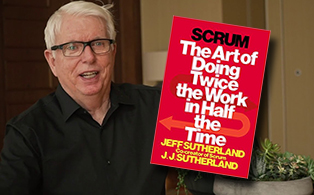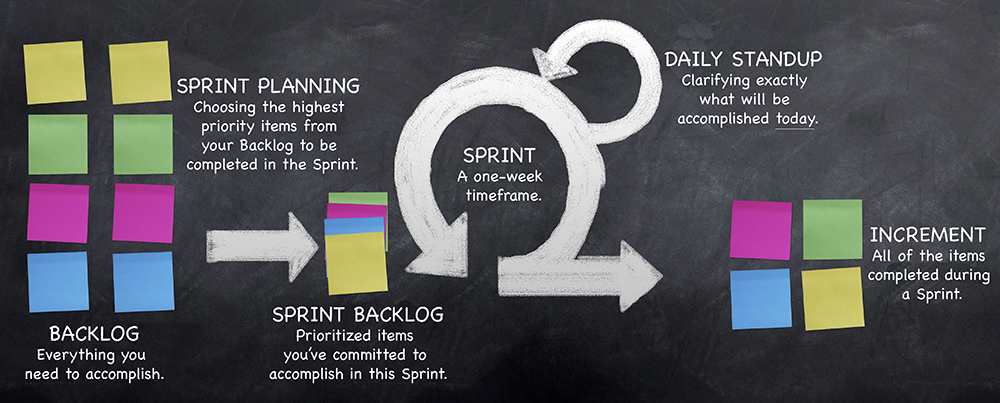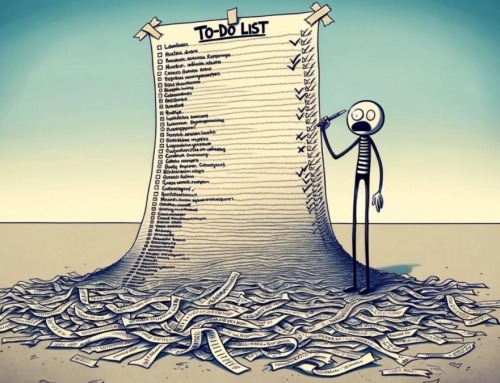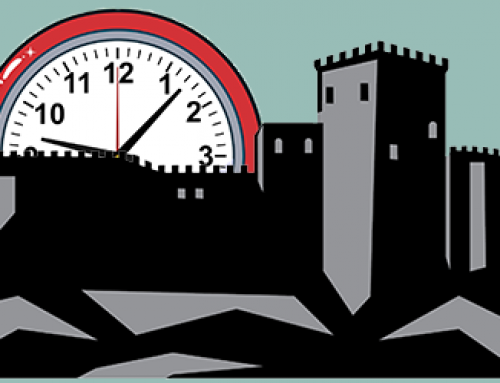Buckle up—because I’m about to sprint through this and explain why Scrum is a great approach to managing your to-do list and accomplishing your goals!
 We all have so many tasks to do. Too many little projects to take care of. Not just at work, but also at home. You have to clean out the garage. You have to plan your child’s birthday party. You have to file our taxes.
We all have so many tasks to do. Too many little projects to take care of. Not just at work, but also at home. You have to clean out the garage. You have to plan your child’s birthday party. You have to file our taxes.
It seems our to-do list is endless. And frankly, it is endless. Once we complete one item we replace it with three more. There must be a way to manage this endless list of tasks.
I’ll come back to managing your to-do list in just a moment.
Scrum: when alignment, unity, and clarity of objective combine to produce successful outcomes
But first, let me introduce you to Jeff Sutherland, who, years ago, was working on seemingly massive IT projects—some which would necessitate years of development. He and his team were barely keeping their heads above the water because of the tsunami of requirements. Even though his team was experienced and intelligent—they just couldn’t keep up.
 Jeff describes the problem in his best-selling book, Scrum: The Art of Doing Twice the Work in Half the Time:
Jeff describes the problem in his best-selling book, Scrum: The Art of Doing Twice the Work in Half the Time:
“It wasn’t that these weren’t smart people. It wasn’t that (we) didn’t have the right personnel in place or even the right technology. It wasn’t about a work ethic or the right supply of competitive juices.
“It was because of the way people were working. The way most people work. The way we all think work has to be done, because that’s the way we were taught to do it.”
A faster, more effective approach to completing objectives
Jeff went on to develop a new framework for team performance called “Scrum.” He describes it:
 “The term comes from the game of rugby, and it refers to the way a team works together to move the ball down the field. Careful alignment, unity of purpose and clarity of goal come together.”
“The term comes from the game of rugby, and it refers to the way a team works together to move the ball down the field. Careful alignment, unity of purpose and clarity of goal come together.”
In other words, Scrum not only increases a team’s speed, but also keeps them focused on their highest priorities. Although many of the techniques and steps in Scrum center on team collaboration, some of its concepts can be used even if you’re a one-person team.
In fact, that’s exactly what I discovered recently when I attended one of Jeff’s seminars. I was pretty skeptical of the idea that you can do twice the work in half the time. It feels a little idealistic—and nothing is ever that simple. I was impressed by Jeff’s challenge, however, to apply Scrum to every aspect of our business—not just the engineering department.
The Scrum approach to team productivity
 Although I live my life in the software world, and have immersed myself in that space for the better part of a decade, I’m not a software developer, I’m not part of the scrum team, but I’ve been fascinated by his approach for years.
Although I live my life in the software world, and have immersed myself in that space for the better part of a decade, I’m not a software developer, I’m not part of the scrum team, but I’ve been fascinated by his approach for years.
And now the very creator of Scrum has given us permission to use this approach anywhere and everywhere we want, in order to get TWICE the work done in HALF the time.
So, where would you start? Where do YOU want to get twice as much done in half the time? Sales? Marketing? Customer service?
The Scrum approach to personal productivity
Better yet, what about your personal life? Confidentially, if I could lose twice the weight in half the time and finish twice as many home improvement projects in half the time that would be pretty amazing! I simply couldn’t decide!
I needed Scrum in every aspect of my life, so I determined the best place to apply Scrum was to my personal productivity first: my to-do list. This is where all those other demands come together in front of me, clamoring for my attention and reminding me how far behind I actually am. Getting twice the work done in half the time in my to-do list would be transformational!”
The fact is, working from a prioritized to-do list, breaking work into iterations, limiting work in progress, and regular reflection are just some of the concepts borrowed from Scrum that we all can use to better manage our personal lives.
Scrum is the perfect balance of efficiency and effectiveness: working faster on correct things. Much of the Scrum framework can apply directly to an individual managing their to-do list and staying on-task and on-time. Let me give you some examples:
Backlog
The Backlog is an ordered list of everything that needs to be done. Sound familiar? A Backlog is essentially a prioritized to-do list. Each task that needs to be accomplished goes into the Backlog and gets ranked in priority orders from most to least important.
Creating the list of everything that needs to be done is therapeutic, albeit overwhelming. In PlanPlus Online, I use our “Unscheduled task list” for my Backlog.”
To create your own Backlog, start listing all the stuff you need to get done. Don’t limit this to just work stuff. It can be doctor appointments, servicing your car, or projects around the house—anything you want to track and complete.
Refinement is the act of adding detail, estimates, and order to items in the Backlog. This is an ongoing process, and just as it needs to happen consistently in the Scrum framework, you need to do it in your own task list just as much.”
A word about prioritization
 Now that you have your Backlog, rank each item. Put the most pressing items at the top. For the top items see if you can break them into smaller tasks. The smaller the task the easier it is to complete. Don’t be afraid to make a single task into smaller tasks that you complete throughout the week.
Now that you have your Backlog, rank each item. Put the most pressing items at the top. For the top items see if you can break them into smaller tasks. The smaller the task the easier it is to complete. Don’t be afraid to make a single task into smaller tasks that you complete throughout the week.
Assign each item an A, B, or C, depending on importance. A’s represent your highest priorities. They must be done. They’re crucial, vital, critical. They should never be procrastinated or ignored. B’s are important. They should be done—but only after you’ve completed your A’s. C’s come in last. C’s could be done, but they’re strictly to be completed after A’s and B’s.
With the ABC123 prioritization built right into my PlanPlus Online to-do list I can create an ordered list of everything that needs to be done. As new requests keep coming in I can add to the Backlog and make sure I don’t drop the ball.
Sprint
A Sprint is a specific timeframe in which you plan to complete a set amount of work. For personal productivity, we suggest one-week Sprints.
For my personal productivity Sprint, I chose a daily Sprint. I like a natural rhythm to my cadence wherever possible. For example, I like to do things every hour, but not every 45 minutes. I like to do things weekly but not every other week. I also didn’t want to wait a week to start seeing results, so daily it is.
Sprint Planning
At the beginning of each new Sprint is a planning session. Estimate how much time each item will take to complete. The easiest way to plan a Sprint is to pull the first few items off your Backlog. Look over each again to see if you can break them into smaller chunks. Estimate each task again if necessary.
This is your weekly planning session. This is a good task to do Sunday night or first thing Monday morning.
I like to use our weekly planning feature in PlanPlus Online to have a dedicated time to “deep dive” into the backlog and ensure I’ve created that ordered list. However, I also find myself revisiting the unscheduled list throughout the week to keep making adjustments.
It may take a few sprints (weeks) to get a feel for how much you can take on in a single week. Remember that as you Scrum yourself you become more productive. In Scrum-speak you’ll increase your velocity.
Stay committed to your objective, stay flexible in your approach
 It’s impossible and unrealistic to plan for everything you’ll encounter during the week. This process isn’t meant to map out all your tasks. It’s to map out your known projects and tasks that you need to complete. You’ll still have plenty of time to put out fires and handle the random stuff that pops up.
It’s impossible and unrealistic to plan for everything you’ll encounter during the week. This process isn’t meant to map out all your tasks. It’s to map out your known projects and tasks that you need to complete. You’ll still have plenty of time to put out fires and handle the random stuff that pops up.
Sprint Planning is how you focus your energy on the next “one thing” that needs to happen to move the ball forward. My Sprint Planning is essentially a daily review of my unscheduled task list where I hand-pick the scope of work I can realistically get done in the day. The more I do this better I’ll get at estimating the right number of tasks to pull from the Backlog, my unscheduled task list, into my Sprint—my Prioritized Daily Task List.
That’s what PlanPlus Online does for me. It helps me start my day with a plan. It allows me to finish my day with a sense of accomplishment and it allows me to connect what I’m doing with why I’m doing it, just like the Scrum framework does for the Scrum team.
Daily Standup
Every morning, have your own personal stand-up meeting. I’m not suggesting you stand in the middle of your office and talk to yourself. Instead, plan your day by asking what items from your Sprint Backlog you will take on today. Think of it as a mini Sprint Planning session.
Also, think about any impediments that are blocking tasks from getting done. Be your own Scrum Master and remove the impediment. Constantly self-reflect and adapt. Spend a few minutes each day planning, reflecting, and asking, “What’s standing in my way?”
Increment
Increment is the sum of all the Backlog items completed during a Sprint. At the end of the day the Increment is a step toward a vision or a goal. Isn’t that what we’re looking for each day? We start our day with a plan (our sprint backlog) we hope to finish our day with a sense of accomplishment.
In order to finish your day with a sense of accomplishment it’s important to make sure the work in your Backlog—your prioritized daily task list—is in alignment with your goals.
I like to use the Compass feature in PlanPlus Online which is next to the task list to ensure that alignment is in place.
By “tagging” my to-do list items with my goals I have more visibility on why I’m doing what I’m doing.
Time blocking or time boxing
Time blocking (or sometimes called time boxing) is the art of intentionally planning your day as a series of time blocks—periods of time devoted to accomplishing just one thing. It’s like putting a fence around that time period in order to keep out distractions and interference.
When fires occur
Being a firefighter is part of our duty. Fires happen all the time and you need to react to them. But if you’re in firefighter mode all day you will rarely do any real work.
However, you can always add fires that pop up to your Sprint Backlog. This means you should remove a lower ranked item and put it back into the larger Backlog. You can take care of this lower ranked item in another sprint.
Jeff concluded by saying:
“What Scrum does is focus you on creating great things, and that requires that you not only see the end goal, but you deliver incrementally toward that goal. How much of your life is wasted on work that doesn’t create any real value? Work today has no room for waste and foolishness.”







